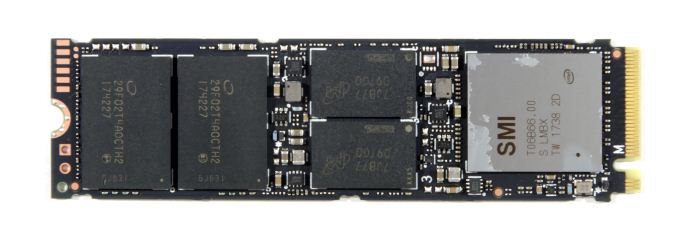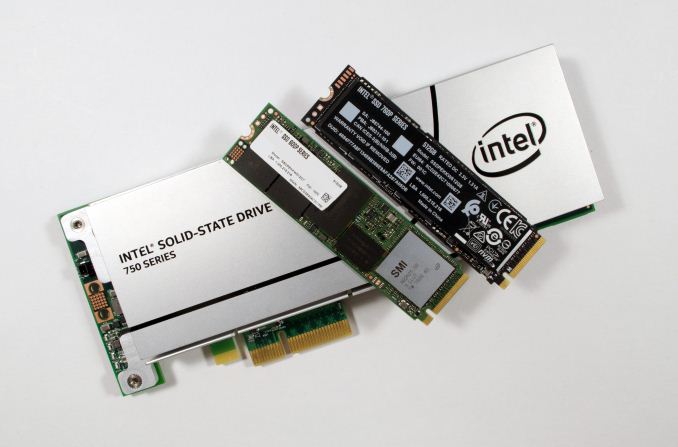
Original Link: https://www.anandtech.com/show/12349/the-intel-ssd-760p-512gb-review
The Intel SSD 760p 512GB Review: Mainstream NVMe Done Right
by Billy Tallis on January 23, 2018 11:30 AM EST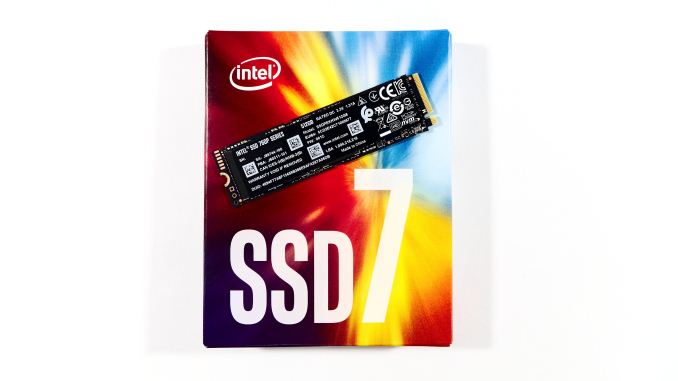
Today Intel is launching a new NVMe SSD for consumers. The Intel SSD 760p is a M.2 SSD featuring Intel's 64-layer 3D TLC NAND flash and a new Silicon Motion controller, and it will compete as an entry-level NVMe SSD.
Based on the model number, the Intel SSD 760p would appear to be successor to the Intel SSD 750. However, the 750 was a top of the line premium SSD for its time, and Intel's Optane products are now covering that market segment. The 760p is a mainstream consumer product with accessible pricing that is slightly lower than the Intel SSD 600p, which has been one of the cheapest NVMe drives on the market. The 600p was Intel's first consumer SSD with 3D NAND and their first M.2 NVMe SSD, and it was also one of the first NVMe SSDs that wasn't even trying to compete at the high end. The 760p promises far better performance than the 600p, but not enough to catch up to today's high-end SSDs.
The Intel SSD 760p is a continuation of Intel's close collaboration with Silicon Motion for consumer SSD controllers. As with the 600p, the 760p features an Intel-customized version of Silicon Motion's reference design and firmware. Where the 600p was based on the SM2260 controller, the 760p is the first drive to market based on the SM2262 controller, the mid-range option from Silicon Motion's second generation of NVMe controllers. Silicon Motion has previewed these controllers last year with far higher performance than the SM2260 could deliver, and the Intel 760p is following through on those promises.
The flash memory used in the Intel SSD 760p is the same 256Gb 64L 3D TLC NAND found in the Intel 545s SATA SSD, and is similar to Micron's 64L 3D TLC as found in the Crucial MX500. Other NAND flash manufacturers have also moved to 64L 3D NAND: Western Digital/SanDisk are using theirs in the WD Blue 3D NAND aka SanDisk Ultra 3D, Toshiba's is found in the TR200 budget SATA SSD, and Samsung's 64L 3D NAND is used in the new 860 PRO and 860 EVO. Intel/Micron 3D NAND is still unique for using a floating gate memory cell structure where their competitors switched to a charge trap cell as part of the transition from planar to 3D NAND.
This year, we will see most manufacturers switch from 256Gb 64L TLC parts to 512Gb 64L TLC, but the Intel 760p still uses the smaller die, which enables higher performance for low-capacity drives.
| Intel SSD 760p Specifications | ||||||
| Capacity | 128 GB | 256 GB | 512 GB | 1 TB | 2 TB | |
| Form Factor | M.2 2280 single-sided | M.2 2280 double-sided | ||||
| Controller | Intel-customized Silicon Motion SM2262 | |||||
| NAND | Intel 256Gb 64-layer 3D TLC | |||||
| Sequential Read | 1640 MB/s | 3210 MB/s | 3230 MB/s | TBA | TBA | |
| Sequential Write | 650 MB/s | 1315 MB/s | 1625 MB/s | TBA | TBA | |
| 4KB Random Read | 105k IOPS | 205k IOPS | 340k IOPS | TBA | TBA | |
| 4KB Random Write | 160k IOPS | 265k IOPS | 275k IOPS | TBA | TBA | |
| Idle Power | 25 mW | TBA | TBA | |||
| Endurance | 72 TBW | 144 TBW | 288 TBW | 576 TBW | 1152 TBW | |
| Warranty | 5 years | |||||
| Price | $72.99 (57¢/GB) | $108.99 (43¢/GB) | $198.99 (39¢/GB) | TBA (Q1 '18) | TBA (Q1 '18) | |
Today's launch includes 128GB, 256GB and 512GB capacities of the Intel 760p, with the 1TB and 2TB models coming later this quarter. All the major performance specifications are much faster than the 600p, and most of them also beat the obsolete Intel SSD 750. The write endurance is rated the same as for the 600p at 72 TB of writes per 128GB of drive capacity, equivalent to about 0.3 drive writes per day, a typical figure for consumer SSDs.
Performance specifications for the 1TB and 2TB models have not been released, but they will probably not be much faster than the 512GB model. The 128GB and 256GB models are clearly held back some by their limited capacity, but the 512GB's performance specs are close to Silicon Motion's projections for what the SM2262 controller would be capable of.
Intel's pricing for the 760p is competitive, with initial MSRPs at or slightly below current street prices for the Intel 600p and most other low-end NVMe drives. The 760p will not hold the 600p's distinction as the cheapest NVMe drive on the market, because a wave of new low-end NVMe drives is arriving. These drives feature cheaper controllers specifically designed for low-end NVMe SSDs, cutting costs by using a PCIe x2 connection instead of x4, or by omitting DRAM in favor of using the NVMe Host Memory Buffer feature. Those drives will enable NVMe SSDs to further encroach on the pricing territory of SATA SSDs, but they may not be able to match the Intel 760p on performance.
As with Intel's other recent consumer SSDs, there will also be variants for the business and embedded markets. Those models will be branded as the Intel SSD Pro 7600p and the Intel SSD E 6100p.
For this review, the Intel SSD 760p will be compared against:
- Intel's previous consumer NVMe SSDs, the high-end Intel SSD 750 and the low-end Intel SSD 600p
- Various Samsung M.2 NVMe SSDs, including the retail 950 PRO, 960 PRO and 960 EVO and the OEM PM981 that is likely to be similar to Samsung's next retail EVO NVMe drive
- The Toshiba XG5 OEM SSD, based on 64-layer 3D TLC NAND. Toshiba's next high-end consumer SSD will likely either be based on the XG5 (the way the RD400 and XG3 share a common platform), or based on this NAND and an updated controller
- Other budget NVMe SSDs using TLC NAND: the Western Digital WD Black that is due for an update to 3D NAND, and the ADATA XPG GAMMIX S10 that is based on a similar controller and NAND combination to the Intel SSD 600p
- Various MLC-based NVMe SSDs that represent last-generation mainstream NVMe performance: the Plextor M8Pe, Toshiba OCZ RD400, Patriot Hellfire.
Absent from this review are members of the upcoming class of NVMe SSDs with controllers designed for the low-end NVMe segment. We have a Silicon Motion SM2263XT engineering sample on hand that is our first drive using the NVMe Host Memory Buffer feature and thus requires more testing than usual. The MyDigitalSSD SBX—the first drive using the Phison E8 controller—just arrived and will get its turn on the testbed next month.
Today's review of the Samsung 860 PRO included synthetic benchmarks conducted with a slightly updated test protocol using fio version 3 for more precise timing measurements. There wasn't time to re-test the necessary NVMe drives for this review, so these results were measured with the older 2017 test scripts using fio version 2.21. Re-testing of our full catalog of SSDs is in progress using the updated scripts and our new Quarch XLC Programmable Power Module for more precise power measurements.
Additionally, both of today's reviews were conducted with systems that have not yet been patched in any way for the Meltdown and Spectre vulnerabilities. A separate testbed has been running tests to measure the impact of various mitigation strategies for those vulnerabilities.
| AnandTech 2017 SSD Testbed | |
| CPU | Intel Xeon E3 1240 v5 |
| Motherboard | ASRock Fatal1ty E3V5 Performance Gaming/OC |
| Chipset | Intel C232 |
| Memory | 4x 8GB G.SKILL Ripjaws DDR4-2400 CL15 |
| Graphics | AMD Radeon HD 5450, 1920x1200@60Hz |
| Software | Windows 10 x64, version 1703 |
| Linux kernel version 4.12, fio version 2.21 | |
- Thanks to Intel for the Xeon E3 1240 v5 CPU
- Thanks to ASRock for the E3V5 Performance Gaming/OC
- Thanks to G.SKILL for the Ripjaws DDR4-2400 RAM
- Thanks to Corsair for the RM750 power supply, Carbide 200R case, and Hydro H60 CPU cooler
- Thanks to Quarch for the XLC Programmable Power Module and accessories
AnandTech Storage Bench - The Destroyer
The Destroyer is an extremely long test replicating the access patterns of very IO-intensive desktop usage. A detailed breakdown can be found in this article. Like real-world usage, the drives do get the occasional break that allows for some background garbage collection and flushing caches, but those idle times are limited to 25ms so that it doesn't take all week to run the test. These AnandTech Storage Bench (ATSB) tests do not involve running the actual applications that generated the workloads, so the scores are relatively insensitive to changes in CPU performance and RAM from our new testbed, but the jump to a newer version of Windows and the newer storage drivers can have an impact.
We quantify performance on this test by reporting the drive's average data throughput, the average latency of the I/O operations, and the total energy used by the drive over the course of the test.
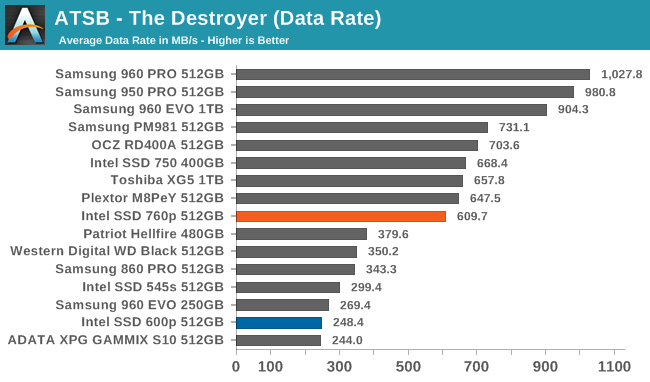
The Intel SSD 760p falls on the good side of a big gap in average data rate scores on The Destroyer. Scoring far below the 760p are SATA drives and most earlier entry-level NVMe SSDs. The 760p is a bit slower than some of the drives using planar MLC NAND or 3D TLC NAND, but it is clear that the 760p is capable of handling The Destroyer better than any previous SSD in its price range.
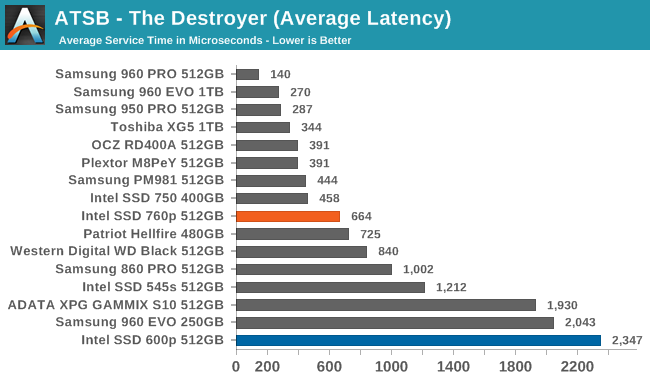
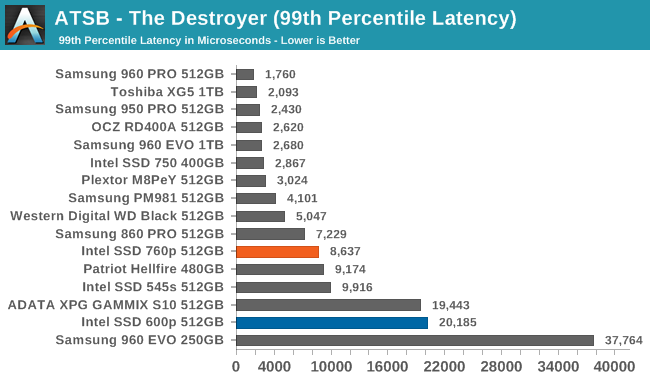
The average and 99th percentile latency scores don't provide the clear separation that the average data rate shows, so the Intel 760p simply looks a bit below average for a NVMe SSD. Given the relative pricing and the poor performance of the Intel 600p, that's a good result for the 760p.
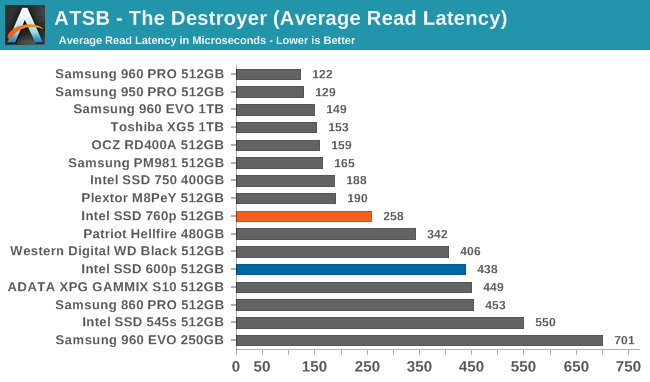
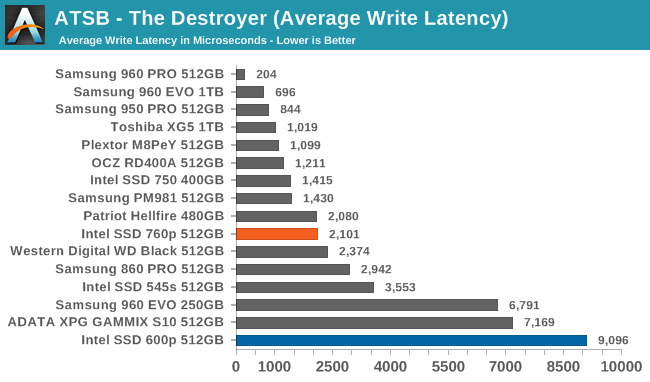
Breaking down the average latency by reads and writes, the Intel SSD 760p ranks about the same either way. It is roughly on par with the slower (read: not Samsung) MLC NVMe SSDs.
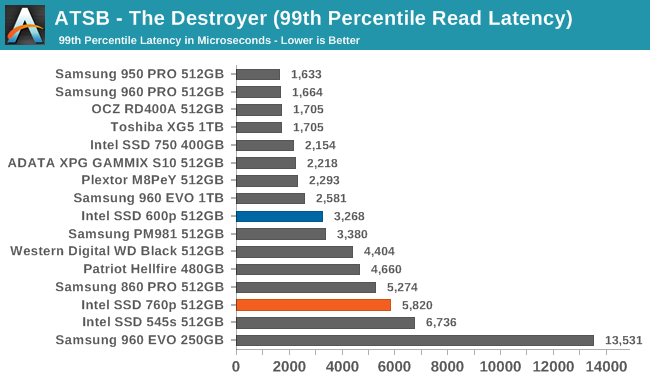
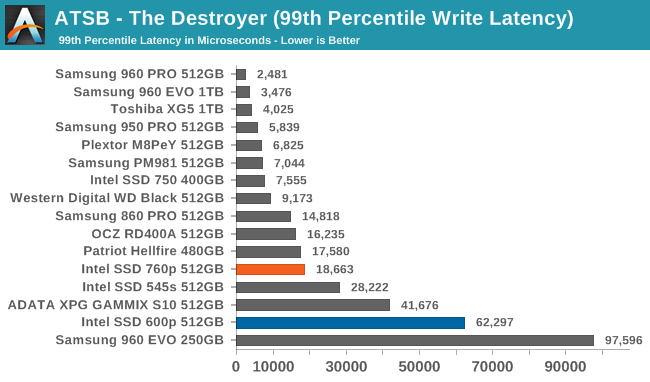
The 99th percentile read latency of the Intel SSD 760p on The Destroyer is rather poor, and the 99th percentile write latency isn't great either. The 760p doesn't seem to have serious problems with garbage collection pauses, but The Destroyer definitely does stress the 760p.
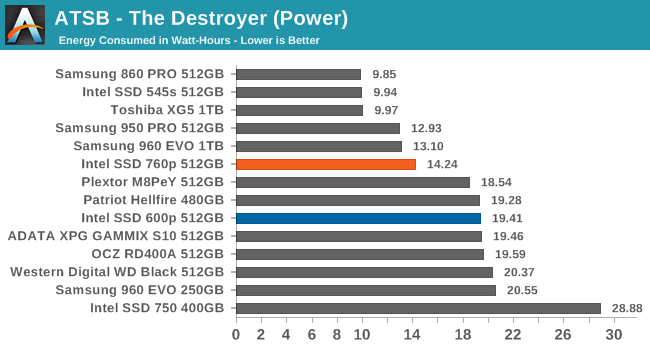
The energy consumption of the Intel SSD 760p during The Destroyer is almost as low as Samsung's best NVMe SSDs, but nowhere near the SATA-like efficiency of the Toshiba XG5. Overall, the 760p is much more efficient than Intel's previous NVMe SSDs, but there's still room for improvement.
AnandTech Storage Bench - Heavy
Our Heavy storage benchmark is proportionally more write-heavy than The Destroyer, but much shorter overall. The total writes in the Heavy test aren't enough to fill the drive, so performance never drops down to steady state. This test is far more representative of a power user's day to day usage, and is heavily influenced by the drive's peak performance. The Heavy workload test details can be found here. This test is run twice, once on a freshly erased drive and once after filling the drive with sequential writes.
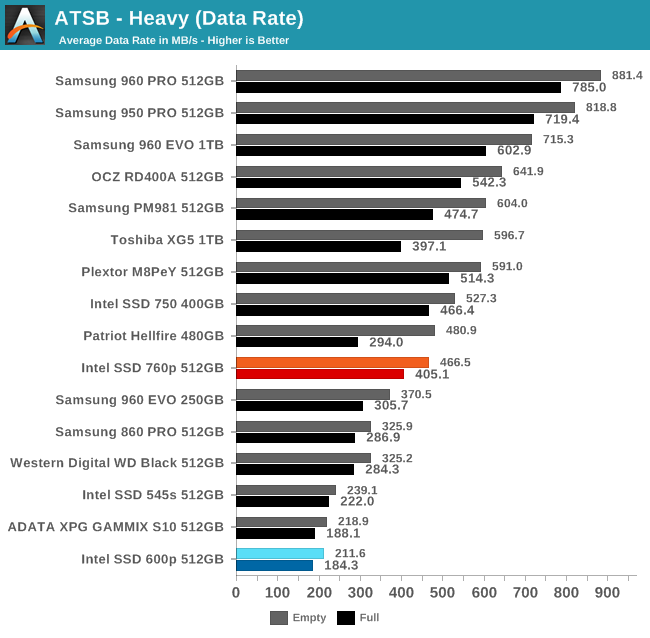
The average data rate of the Intel SSD 760p on the Heavy test makes it clear that the 760p is not a high-end NVMe drive, but it does perform much better than SATA SSDs and previous low-end NVMe SSDs. The 760p also handles being full relatively well, so its SLC caching strategy seems well done.
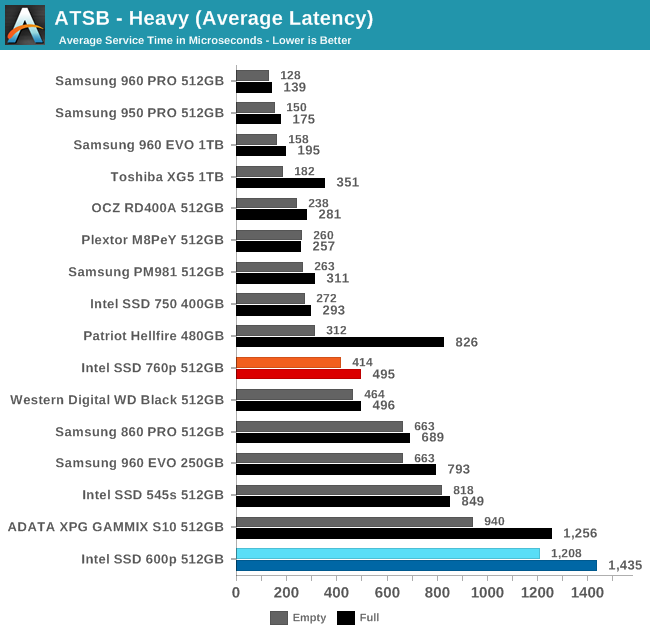
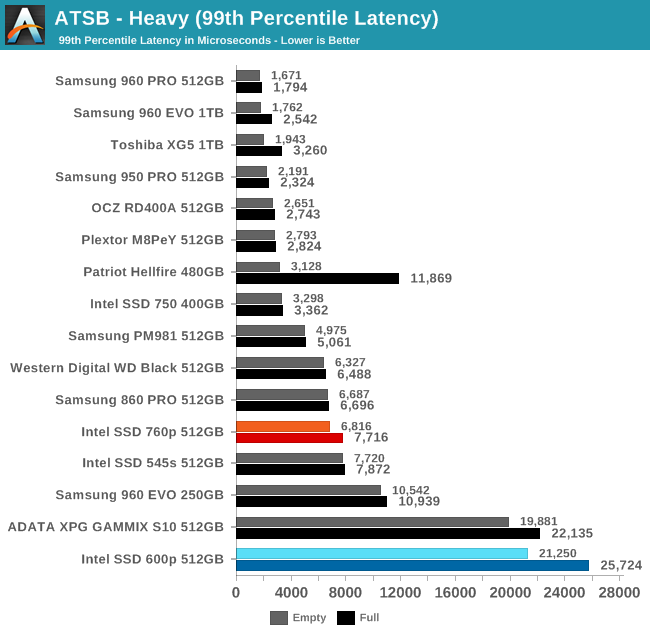
The average and 99th percentile latency scores of the 760p aren't great, but they're still a big improvement over most earlier low-end NVMe SSDs. The 99th percentile latency has more room for improvement, since it is no better than a good SATA SSD.
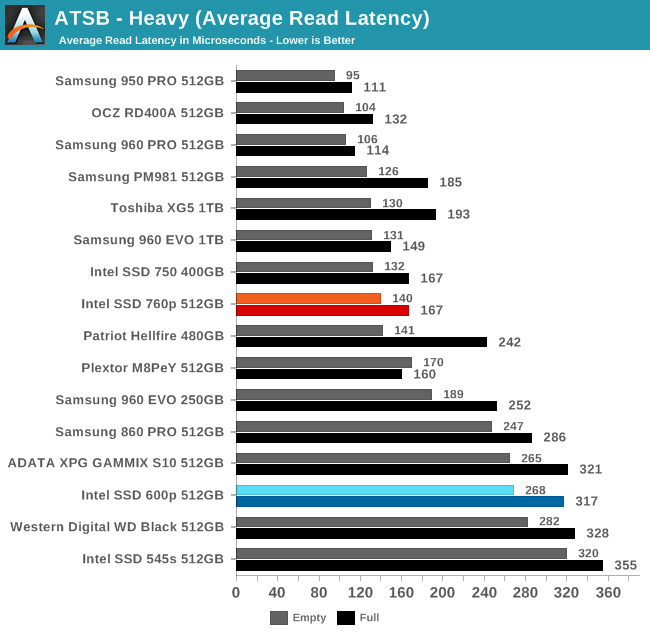
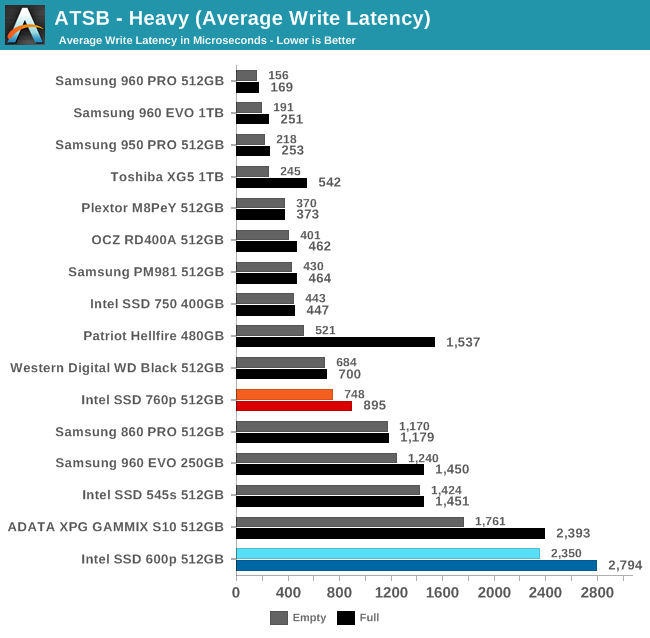
The average read latencies of the Intel SSD 760p on the Heavy test are not quite as good as a high-end NVMe SSD but are definitely close enough for a product this cheap. The average write latencies are more in line with some of the better previous budget NVMe SSDs, and are close to the level of SATA SSDs.
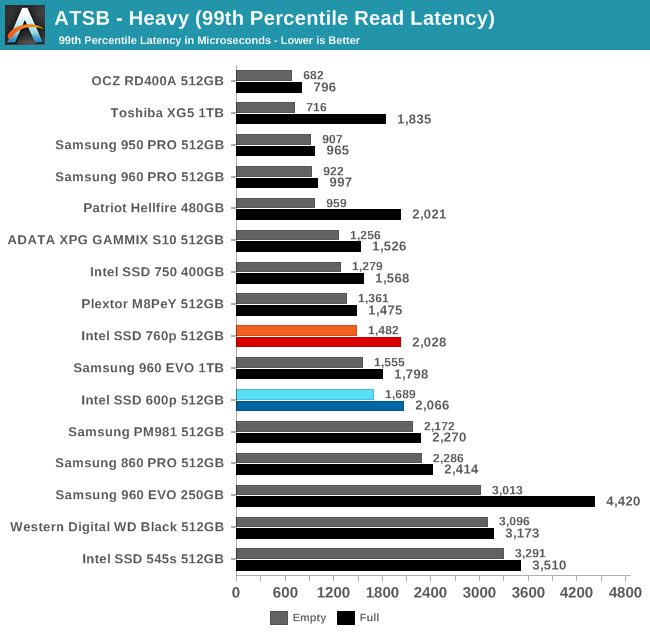
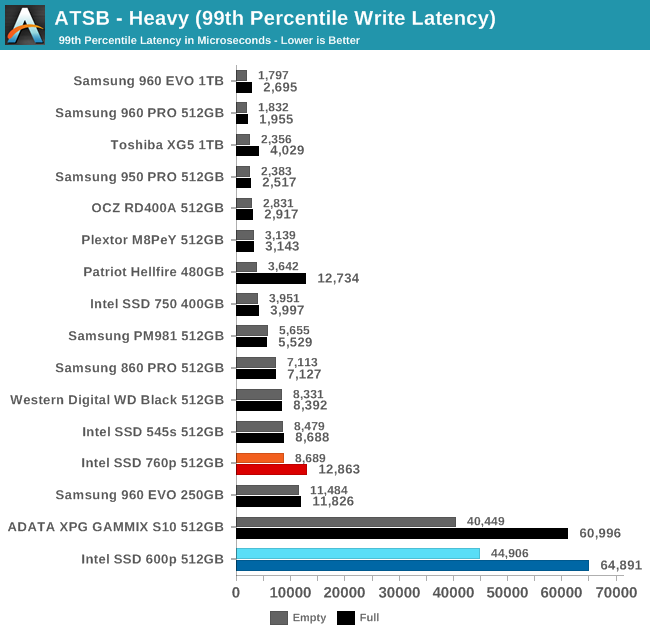
The 99th percentile read latencies from the Intel 760p don't particularly stand out, and are reasonable for this product segment. The 99th percentile write latency scores are rather high, but not to egregiously like the Intel SSD 600p and a similar ADATA drive.
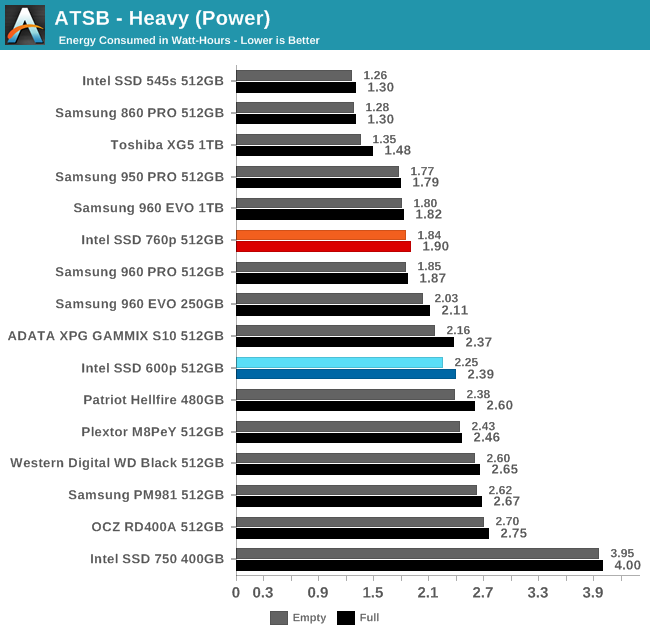
As with The Destroyer, the Intel SSD 760p shows very good power efficiency by NVMe standards, but the SATA drives and the Toshiba XG5 show that there's still room for much improvement.
AnandTech Storage Bench - Light
Our Light storage test has relatively more sequential accesses and lower queue depths than The Destroyer or the Heavy test, and it's by far the shortest test overall. It's based largely on applications that aren't highly dependent on storage performance, so this is a test more of application launch times and file load times. This test can be seen as the sum of all the little delays in daily usage, but with the idle times trimmed to 25ms it takes less than half an hour to run. Details of the Light test can be found here. As with the ATSB Heavy test, this test is run with the drive both freshly erased and empty, and after filling the drive with sequential writes.
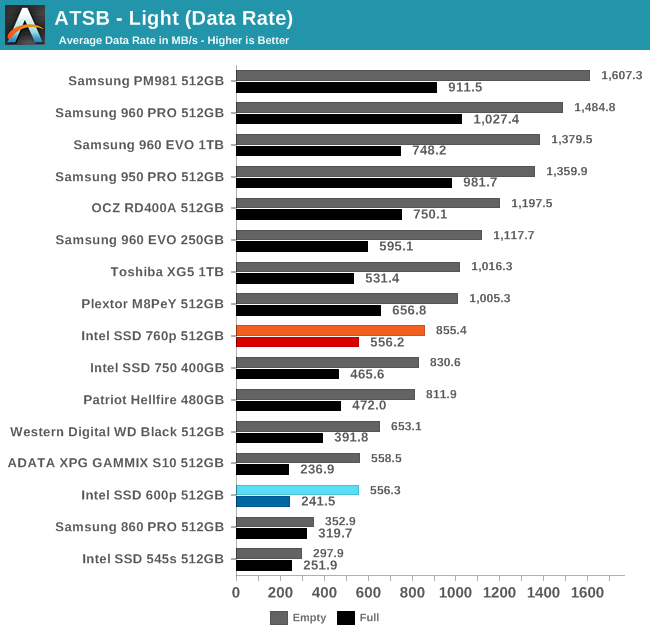
The Light test reveals bigger performance differences for full and empty drive states than the Heavy test, but the 760p doesn't suffer as much as most drives. The average data rates from the 760p are slightly higher than from the Intel SSD 750, and much higher than the 600p or the SATA drives. On the other hand, the TLC-based Samsung PM981 is almost twice as fast.
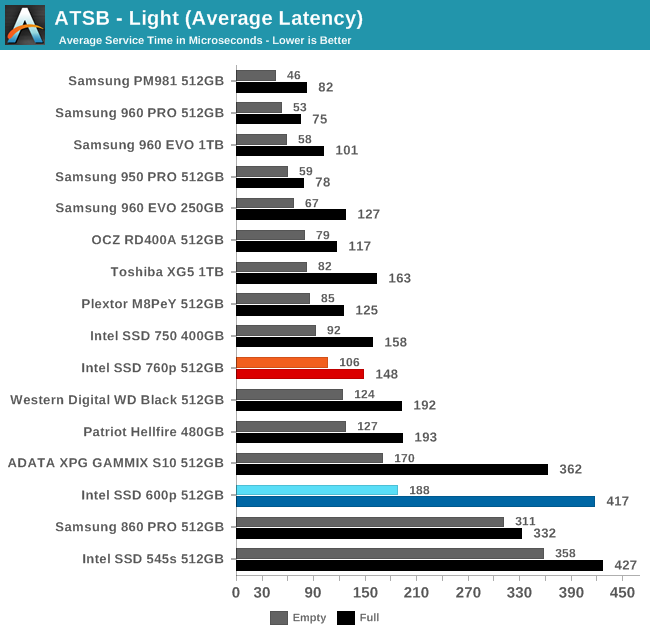
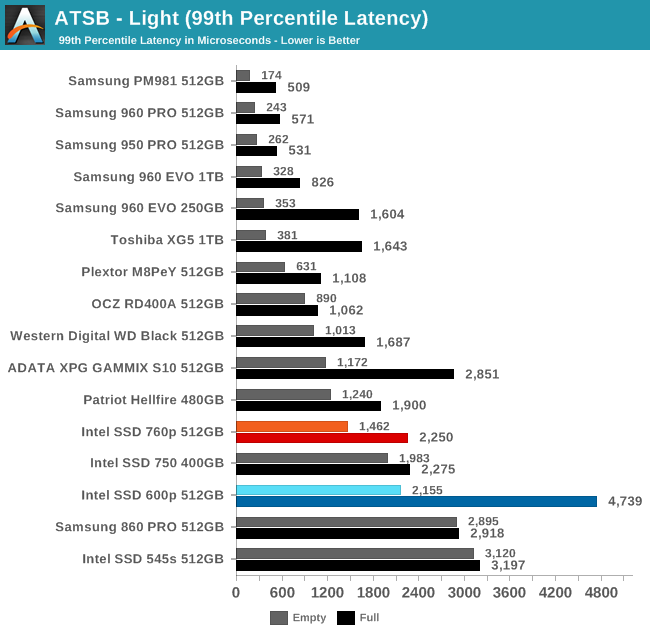
The average latency scores of the Intel SSD 760p are twice those of the fastest NVMe SSDs, but this isn't enough to amount to a noticeable difference on a light workload. The 99th percentile latencies are much higher than those of Samsung's NVMe drives, but are still faster than SATA SSDs.
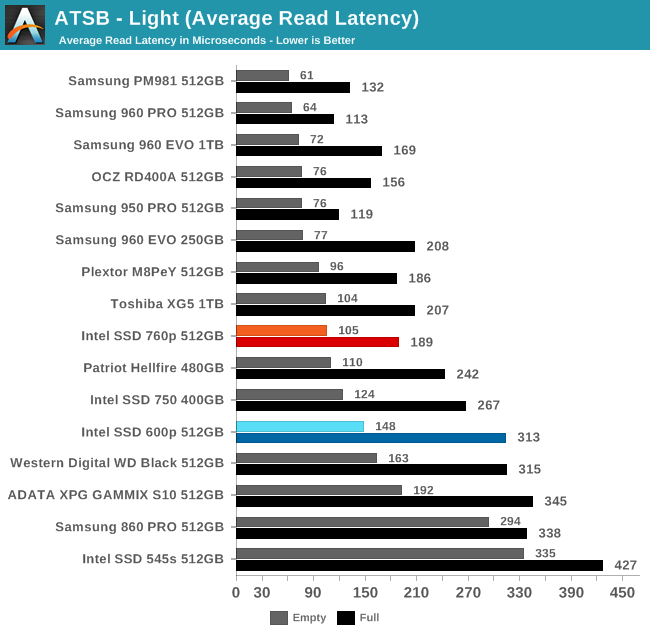
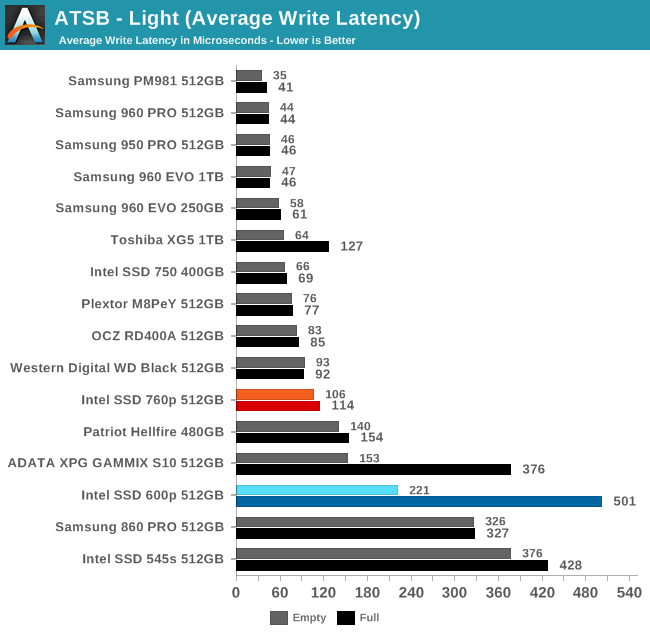
The average read latencies from the Intel 760p fall into the middle of the range for NVMe SSDs, but the average write latencies are clearly on the high side of normal.

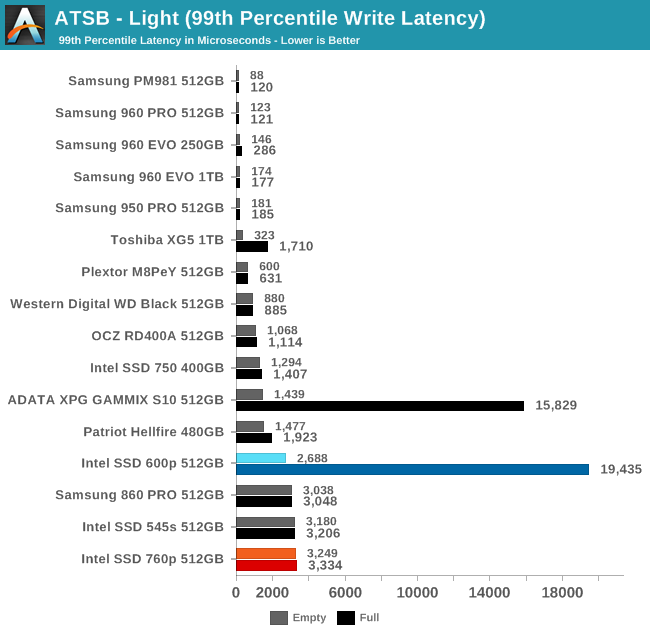
The 99th percentile read latencies of the 760p on the Light test are acceptable for a low-end NVMe SSD, but the full-drive score is actually slightly worse than the Intel 600p. On the write side, the 99th percentile latency is actually very slightly worse than good SATA SSDs, but the 760p doesn't get noticeably worse when full.
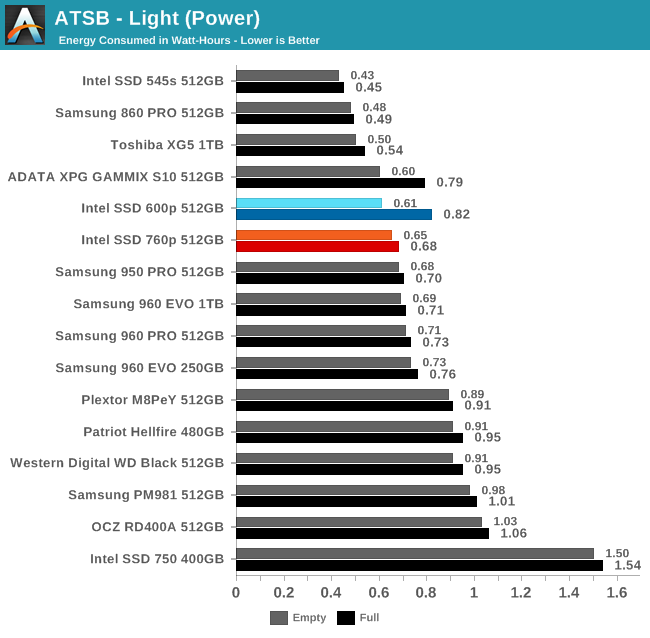
The two SM2260-based NVMe SSDs join the Toshiba XG5 this time as the most efficient NVMe SSDs ahead of the Intel 760p, but the SM2260-based 600p and GAMMIX S10 fall behind when the test is run on a full drive. The Samsung drives mostly use slightly more power than the 760p, but the PM981 ends up near the bottom of the chart.
Random Read Performance
Our first test of random read performance uses very short bursts of operations issued one at a time with no queuing. The drives are given enough idle time between bursts to yield an overall duty cycle of 20%, so thermal throttling is impossible. Each burst consists of a total of 32MB of 4kB random reads, from a 16GB span of the disk. The total data read is 1GB.
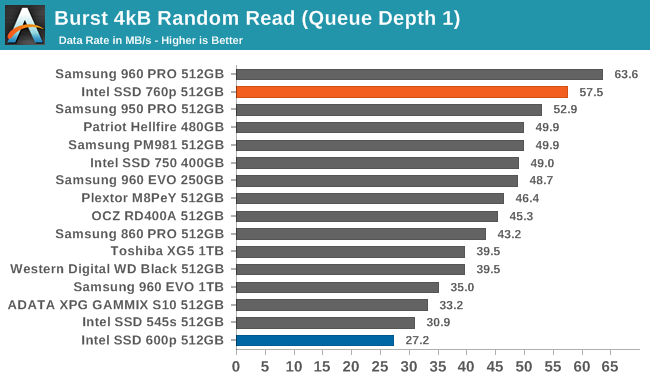
The burst random read performance of the Intel SSD 760p is great, even when compared against MLC-based NVMe SSDs. Samsung's 960 PRO is the only flash-based consumer SSD that currently beats the read latency of the 760p. The 760p has more than doubled the QD1 random read performance of the Intel SSD 600p, and is 17% faster than the Intel SSD 750.
Our sustained random read performance is similar to the random read test from our 2015 test suite: queue depths from 1 to 32 are tested, and the average performance and power efficiency across QD1, QD2 and QD4 are reported as the primary scores. Each queue depth is tested for one minute or 32GB of data transferred, whichever is shorter. After each queue depth is tested, the drive is given up to one minute to cool off so that the higher queue depths are unlikely to be affected by accumulated heat build-up. The individual read operations are again 4kB, and cover a 64GB span of the drive.
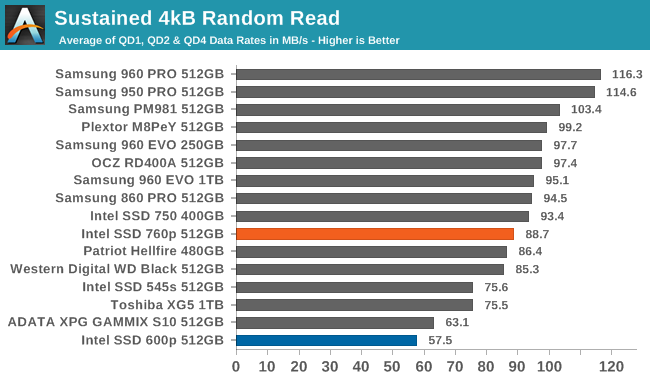
With a longer test runtime and some higher queue depths involved, the Intel SSD 760p no longer stands out from the crowd. Its sustained random read performance is reasonable given its pricing and the current field of competitors, but in a few months time it may be looking rather sluggish. The 760p is about 5% slower than the Intel SSD 750, but on the other hand it is 54% faster than the 600p.
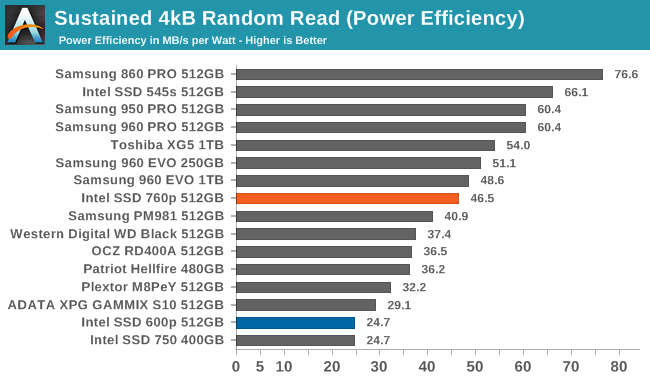
The power efficiency of the Intel SSD 760p during random reads is about average. Samsung's SSDs dominate the top half of the chart, and the two SATA SSDs hold the top two spots, showing that the performance of NVMe SSDs still doesn't offset their increased power consumption. Intel's previous consumer NVMe SSDs are tied for last place in power efficiency: the 750 is reasonably fast but power hungry, while the 600p has more modest power requirements but is quite slow.
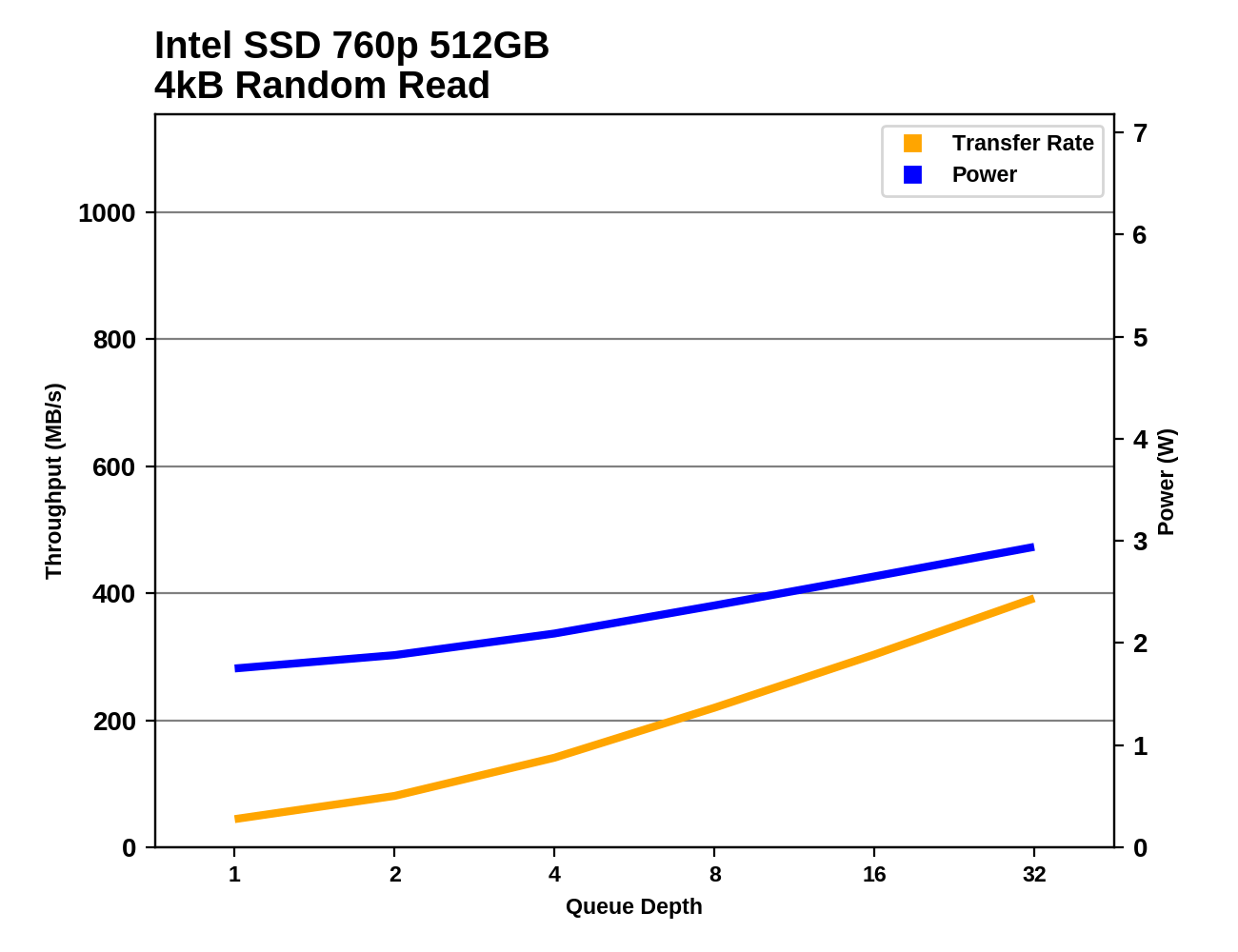 |
|||||||||
The Intel SSD 760p has decent random read performance at low queue depths, but it doesn't scale well at all with higher queue depths. By QD4, Samsung's drives have started pulling away, and at QD8 and higher most drives are faster than the 760p. Even Samsung's SATA SSDs have a clear lead over the 760p before they hit the wall of SATA performance limits. At QD32, most other NVMe drives are much faster than the 760p, and the high-end drives are all at least twice as fast.
The power consumption of the Intel SSD 760p during the sustained random read test is lower than any NVMe SSD we've tested so far except the Toshiba XG5.
Random Write Performance
Our test of random write burst performance is structured similarly to the random read burst test, but each burst is only 4MB and the total test length is 128MB. The 4kB random write operations are distributed over a 16GB span of the drive, and the operations are issued one at a time with no queuing.
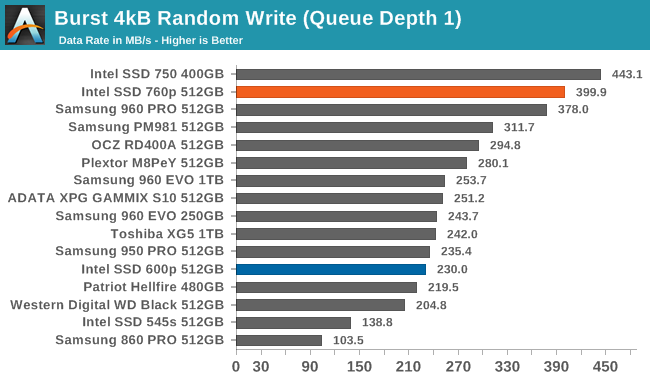
The burst random write performance of the Intel SSD 760p is second only to the Intel SSD 750. Since the 750 is based on an enterprise SSD platform with MLC NAND, this regression isn't at all surprising. That the 760p manages to beat the Samsung 960 PRO is quite an accomplishment. The 760p is also 73% faster than the Intel 600p on this test.
As with the sustained random read test, our sustained 4kB random write test runs for up to one minute or 32GB per queue depth, covering a 64GB span of the drive and giving the drive up to 1 minute of idle time between queue depths to allow for write caches to be flushed and for the drive to cool down.
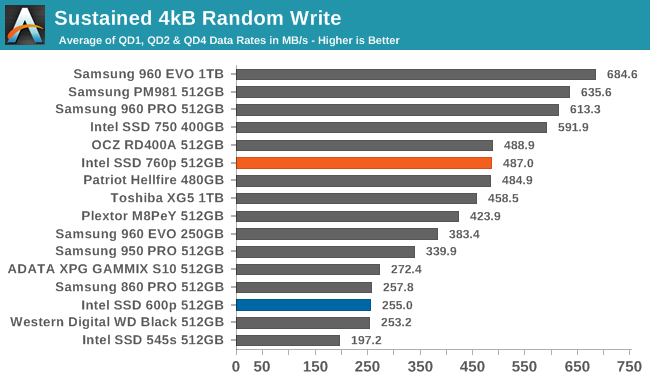
On the sustained random write test that involves some higher queue depths, the performance of the Intel SSD 760p is good but not outstanding. Several of Samsung's drives and the Intel SSD 750 are faster. However, the 760p is on par with some of the slower MLC-based competitors and is almost twice as fast as the Intel SSD 600p.
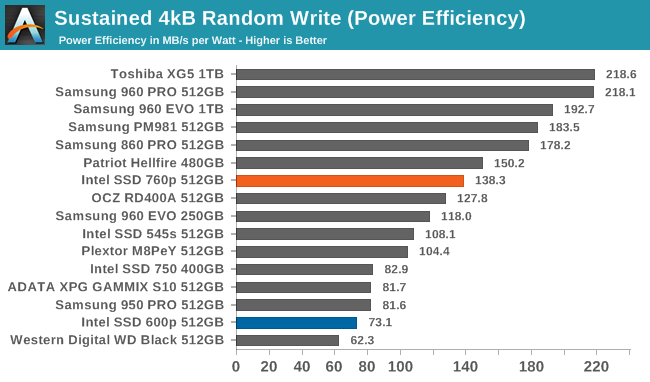
The power efficiency of the Intel SSD 760p during random writes is a bit above average, and is substantially better than any previous Intel consumer SSD. The Toshiba XG5 and most of Samsung's recent drives are far more efficient.
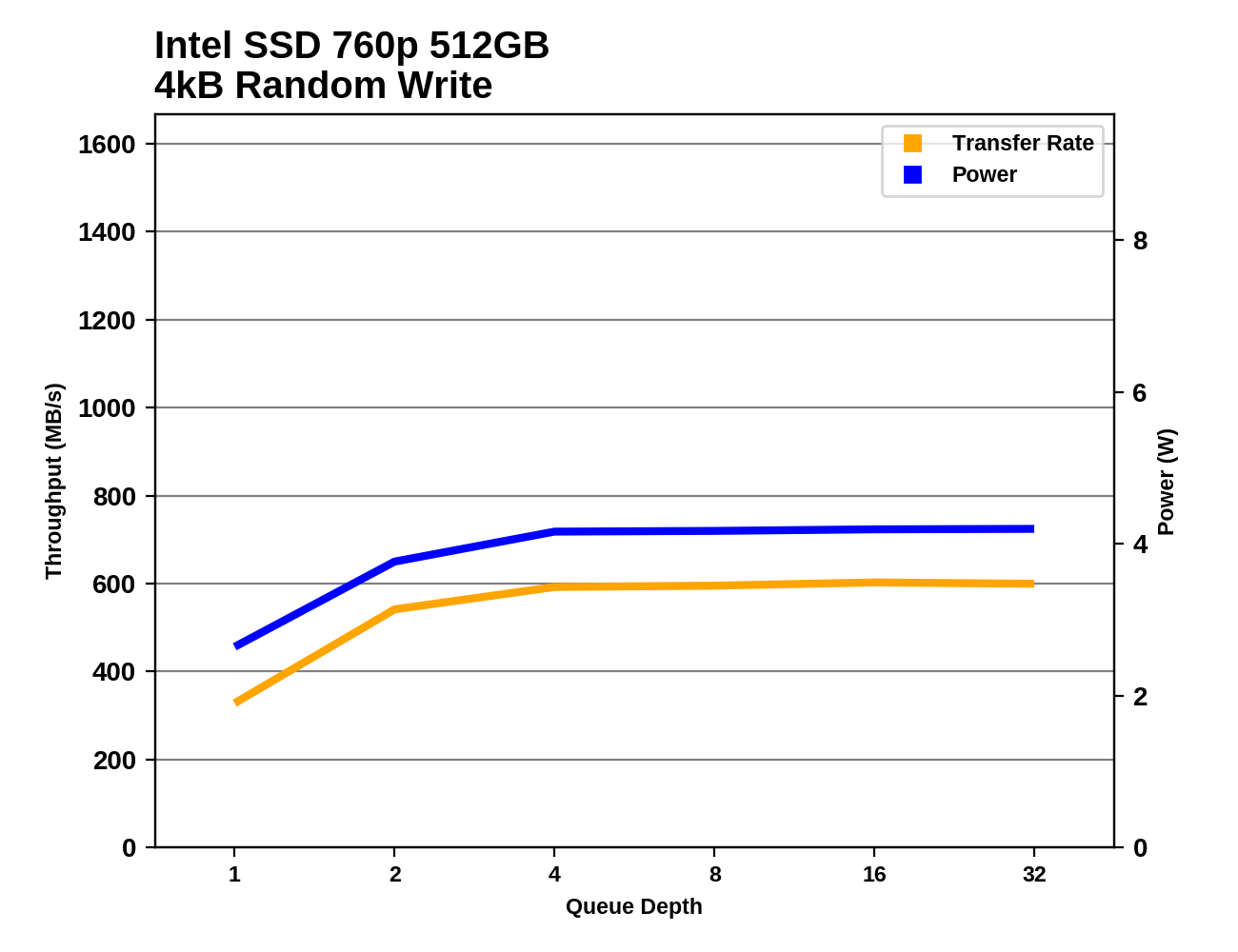 |
|||||||||
The random write performance of the Intel SSD 760p saturates around QD4 at 600 MB/s. Most high-end NVMe drives continue showing improvement up to QD8, and the Samsung 960 PRO and EVO both top out with over twice the throughput of the Intel SSD 760p. The 760p is delivering twice the performance of the Intel SSD 600p with the same power consumption, but that's one of the few comparisons where the 760p is the clear winner.
Sequential Read Performance
Our first test of sequential read performance uses short bursts of 128MB, issued as 128kB operations with no queuing. The test averages performance across eight bursts for a total of 1GB of data transferred from a drive containing 16GB of data. Between each burst the drive is given enough idle time to keep the overall duty cycle at 20%.
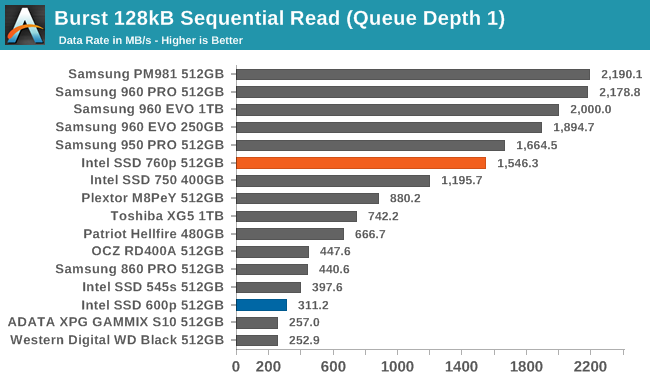
The burst sequential read speed of the Intel SSD 760p is a substantial improvement over the Intel SSD 750 and 600p, but isn't quite fast enough to match Samsung's NVMe SSDs.
Our test of sustained sequential reads uses queue depths from 1 to 32, with the performance and power scores computed as the average of QD1, QD2 and QD4. Each queue depth is tested for up to one minute or 32GB transferred, from a drive containing 64GB of data.
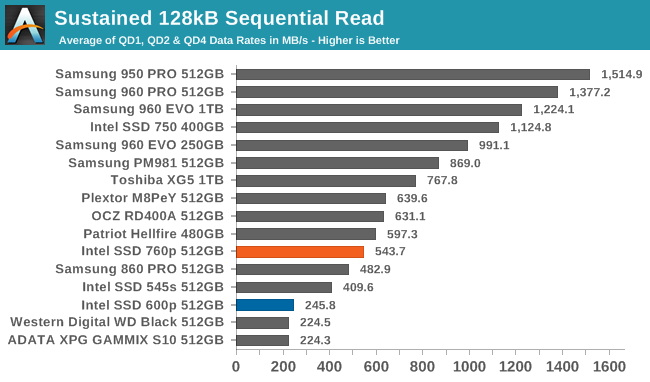
The sustained sequential read speed of the Intel SSD 760p is only slightly above SATA SSD speeds. This makes it more than twice as fast as the Intel SSD 600p, but still far slower than other recent NVMe SSDs using 3D TLC NAND such as the Toshiba XG5 and the Samsung PM981.
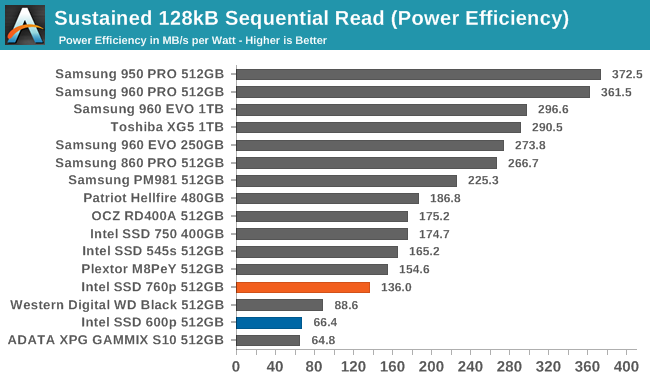
With subpar performance, it isn't surprising to see the Intel SSD 760p score near the bottom for power efficiency. There are a few TLC-based NVMe SSDs that score even worse—including the Intel SSD 600p—but there's clearly a lot of room for improvement here.
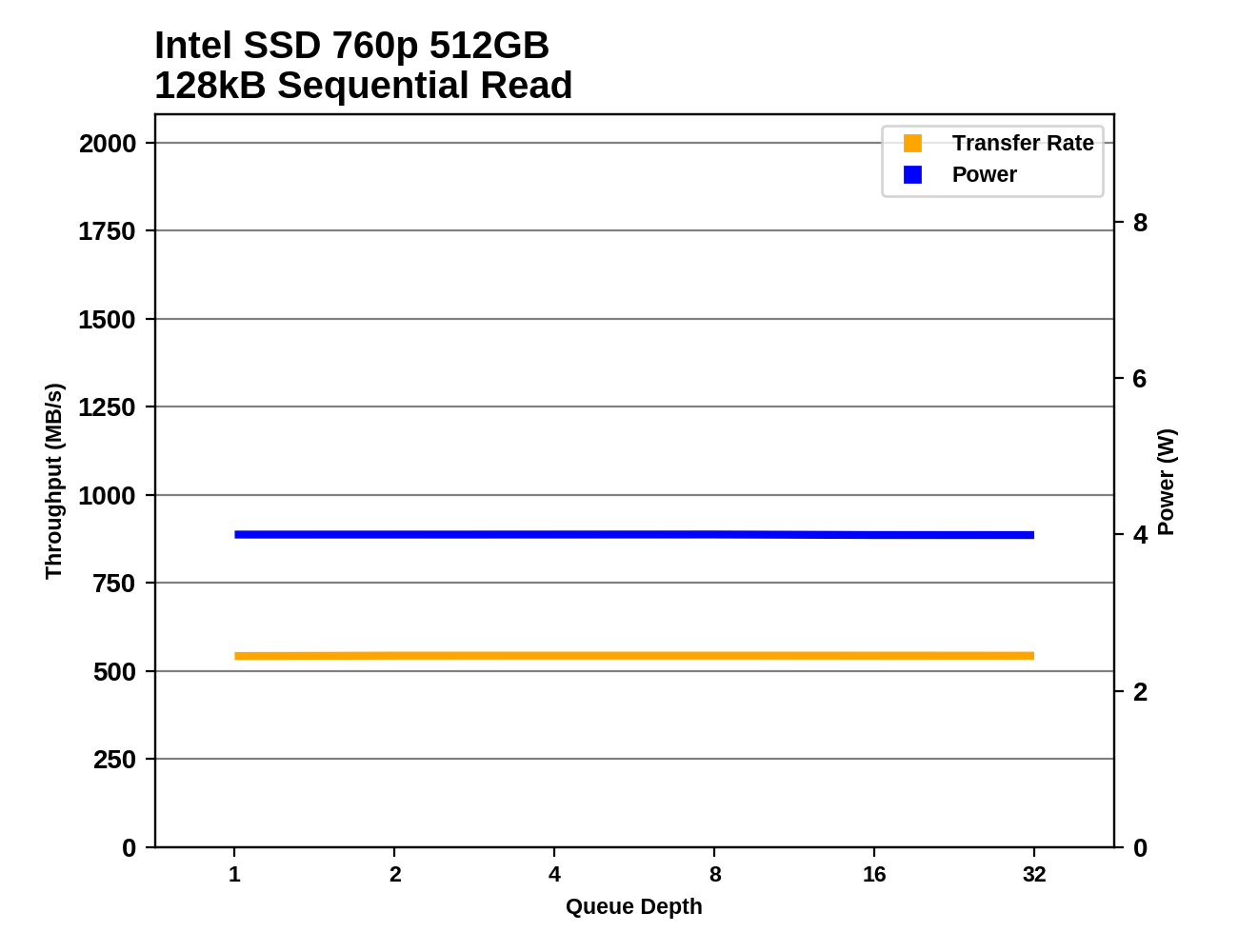 |
|||||||||
The Intel SSD 760p hits its full sequential read speed at QD1, while the 600p required QD4 or higher to offer its full speed. Like most other M.2 NVMe SSDs, the Intel 760p draws about 4W at full speed, and the efficiency differences between drives are mostly due to differences in speed, not power consumption.
Sequential Write Performance
Our test of sequential write burst performance is structured identically to the sequential read burst performance test save for the direction of the data transfer. Each burst writes 128MB as 128kB operations issued at QD1, for a total of 1GB of data written to a drive containing 16GB of data.
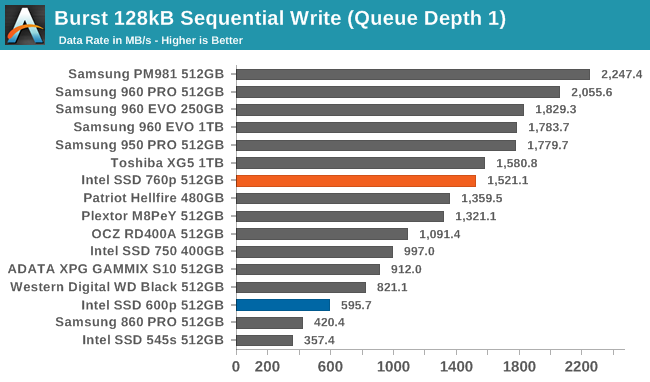
The burst sequential write speed of the Intel SSD 760p is slightly above average and far above Intel's previous flash-based SSDs. It is only slightly slower than the larger 1TB Toshiba XG5, and about 15–20% slower than Samsung's NVMe SSDs.
Our test of sustained sequential writes is structured identically to our sustained sequential read test, save for the direction of the data transfers. Queue depths range from 1 to 32 and each queue depth is tested for up to one minute or 32GB, followed by up to one minute of idle time for the drive to cool off and perform garbage collection. The test is confined to a 64GB span of the drive.
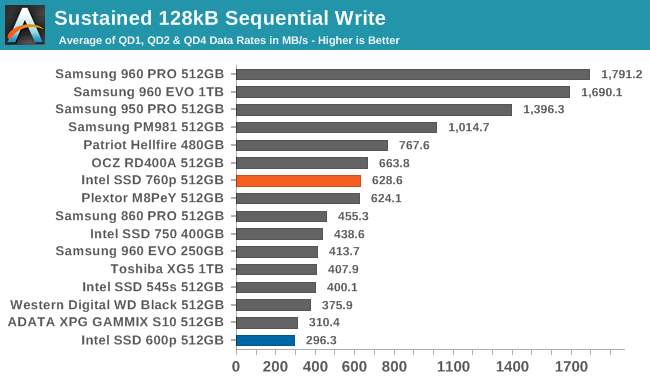
The sustained sequential write speed of the Intel SSD 760p is comfortably above the limits of the SATA interface, which many NVMe SSDs can't manage. However, the Samsung PM981 is 60% faster than the 760p, and the 960 PRO is almost three times faster. The performance of the 760p is reasonable for a low-end NVMe SSD, but it can't compete at the high end.
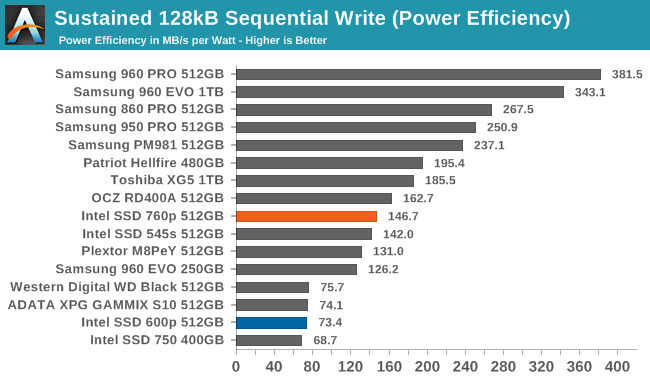
The power efficiency of the Intel SSD 760p on the sequential write test is slightly below average. This is twice the efficiency of Intel's previous NVMe SSDs, but substantially worse than more recent drives from Samsung and Toshiba.
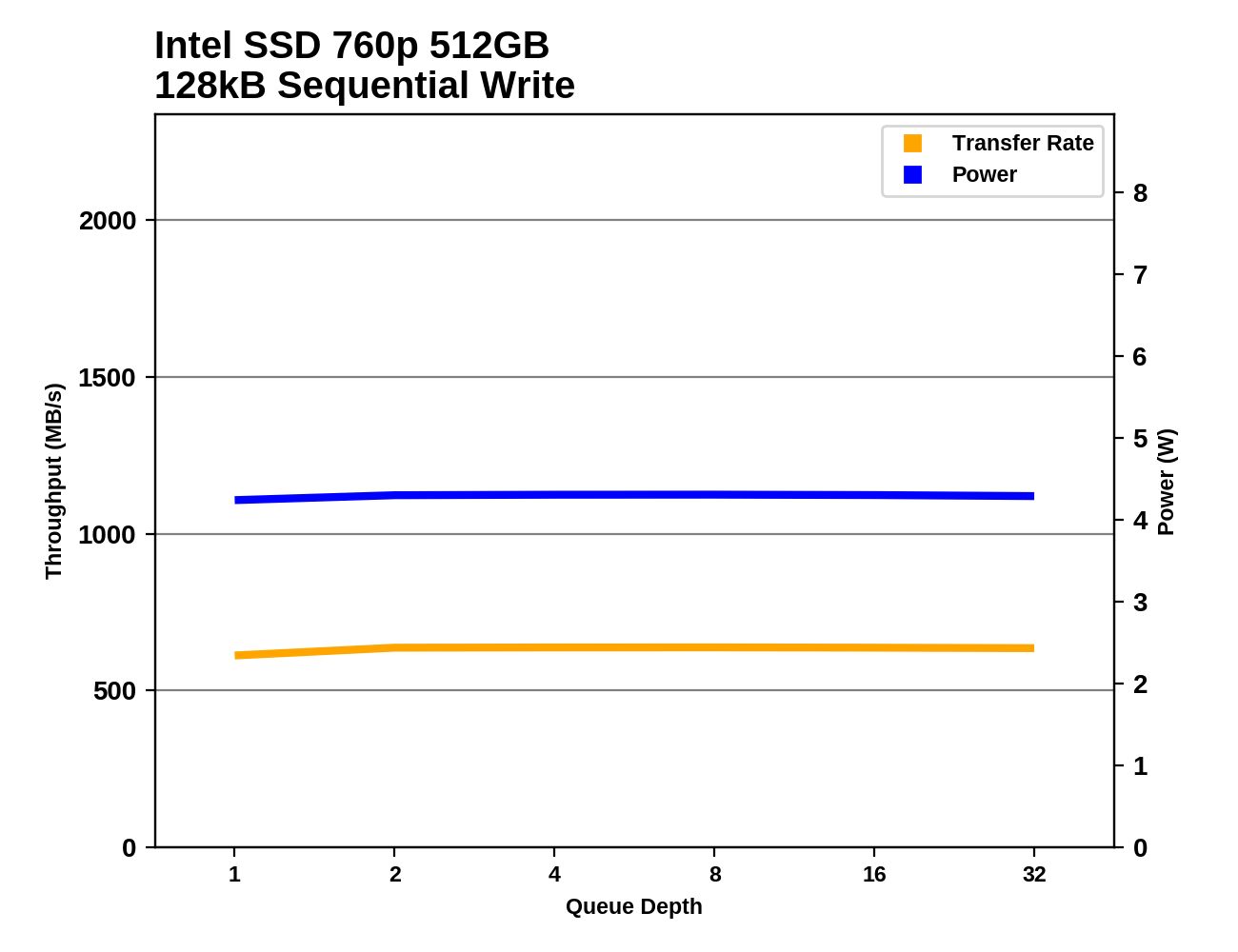 |
|||||||||
The Intel SSD 760p is very close to its full sequential write speed at QD1, and its performance is steady across the entire test—a marked improvement over the 600p and many other low-end NVMe SSDs. Samsung's PM981 delivered uneven performance on this test but was much faster overall with about the same power draw as the 760p.
Mixed Random Performance
Our test of mixed random reads and writes covers mixes varying from pure reads to pure writes at 10% increments. Each mix is tested for up to 1 minute or 32GB of data transferred. The test is conducted with a queue depth of 4, and is limited to a 64GB span of the drive. In between each mix, the drive is given idle time of up to one minute so that the overall duty cycle is 50%.
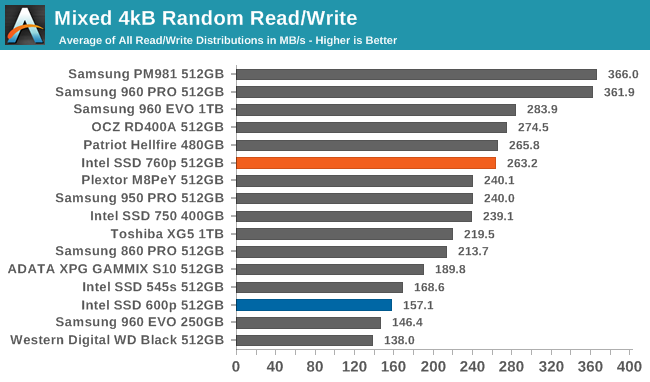
The overall performance of the Intel SSD 760p on the mixed random I/O performance is quite high for a TLC-based drive. Samsung's PM981 is much better, but the 512GB 760p is almost as fast as the 1TB Samsung 960 EVO. The 760p is clearly a viable competitor to the non-Samsung drives that use MLC NAND flash.
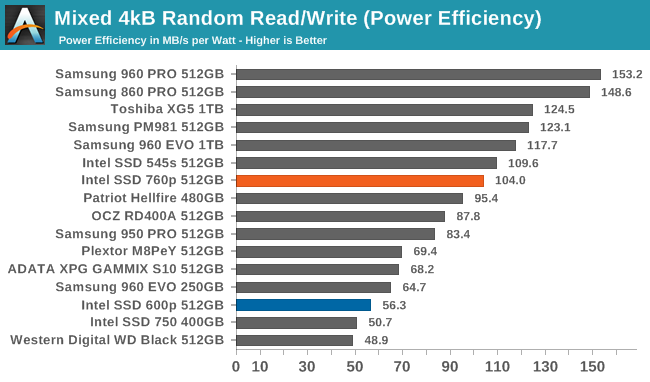
The Intel SSD 760p does not score quite as well for power efficiency as it does for raw performance on the mixed random I/O test, but it is still above average and far better than previous Intel SSDs.
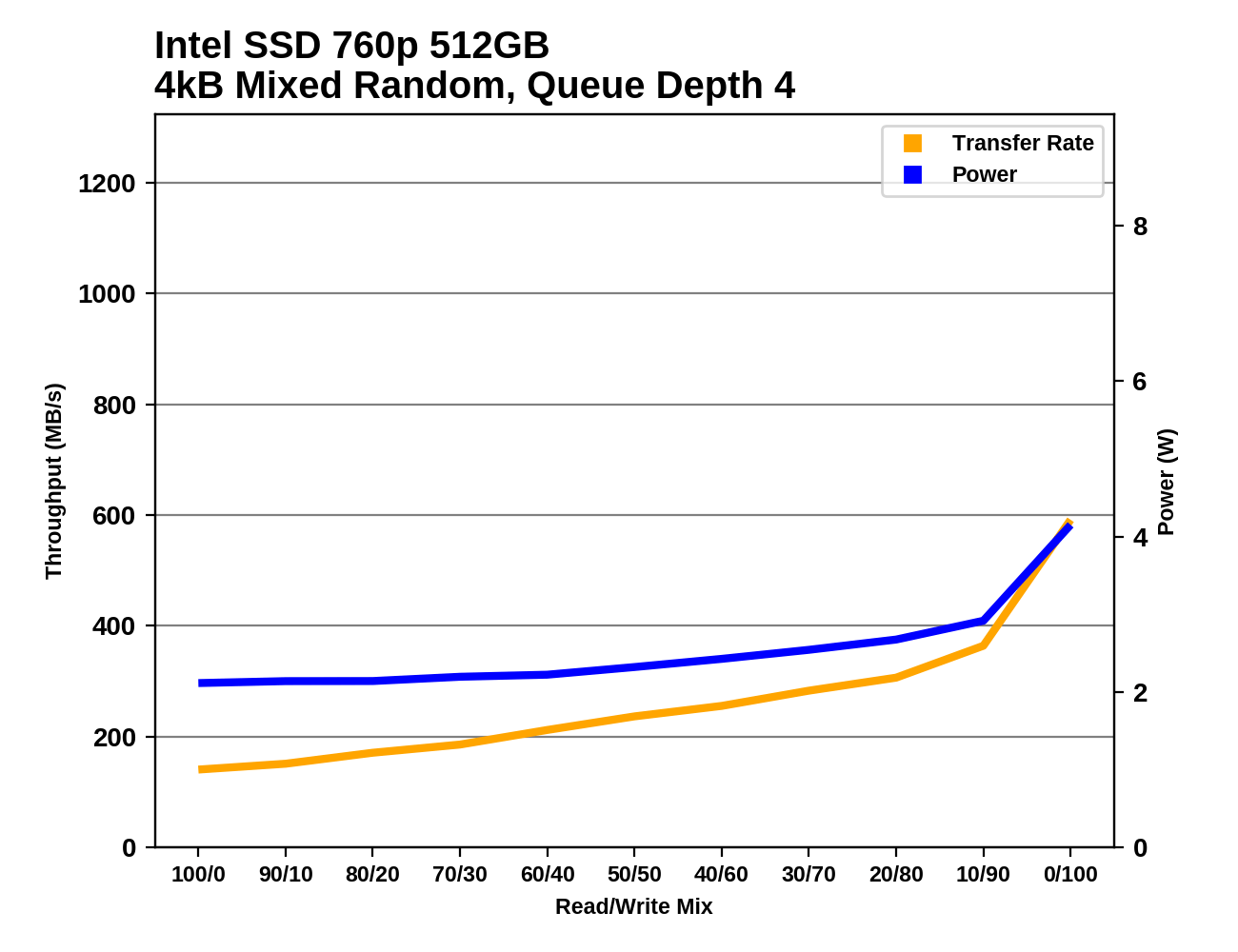 |
|||||||||
The random I/O performance of the Intel SDD 760p increases gradually but steadily as the proportion of writes increases. It's a good sign that there are no dips in performance along the way, but the performance on the final phase of the test with a pure random write workload is not competitive with the high-end SSDs.
Mixed Sequential Performance
Our test of mixed sequential reads and writes differs from the mixed random I/O test by performing 128kB sequential accesses rather than 4kB accesses at random locations, and the sequential test is conducted at queue depth 1. The range of mixes tested is the same, and the timing and limits on data transfers are also the same as above.
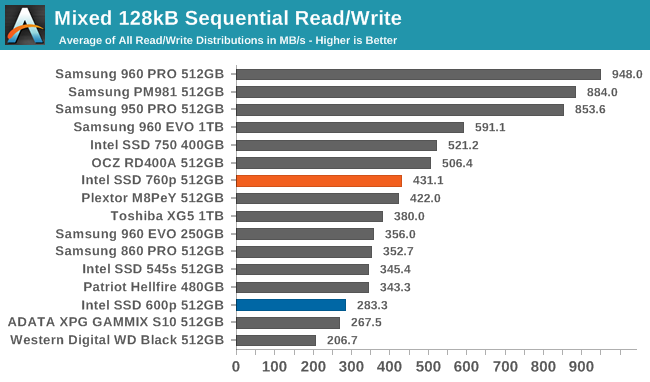
The average performance of the Intel SSD 760p on the mixed sequential workload test does not exceed the limits of a SATA link, but it does clearly beat the best speed achieved by a SATA drive on this test. Previous budget NVMe SSDs have failed to even match the fastest SATA SSDs due to the use of slow TLC NAND.
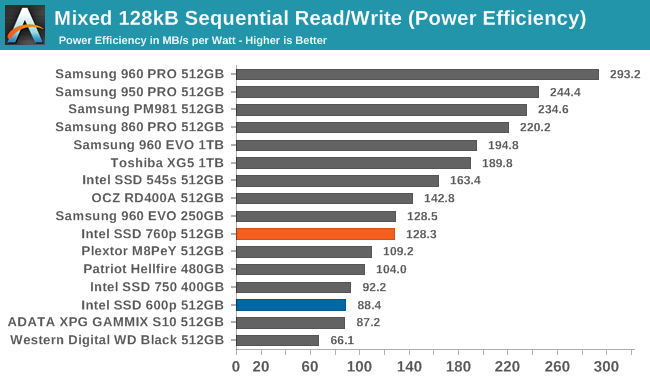
The power efficiency of the Intel SSD 760p on the mixed sequential I/O test is not great. It only beats drives that were notably slow (600p, WD Black) or unusually power-hungry (Intel 750, Plextor M8PeY). Samsung and Toshiba have set a much higher standard.
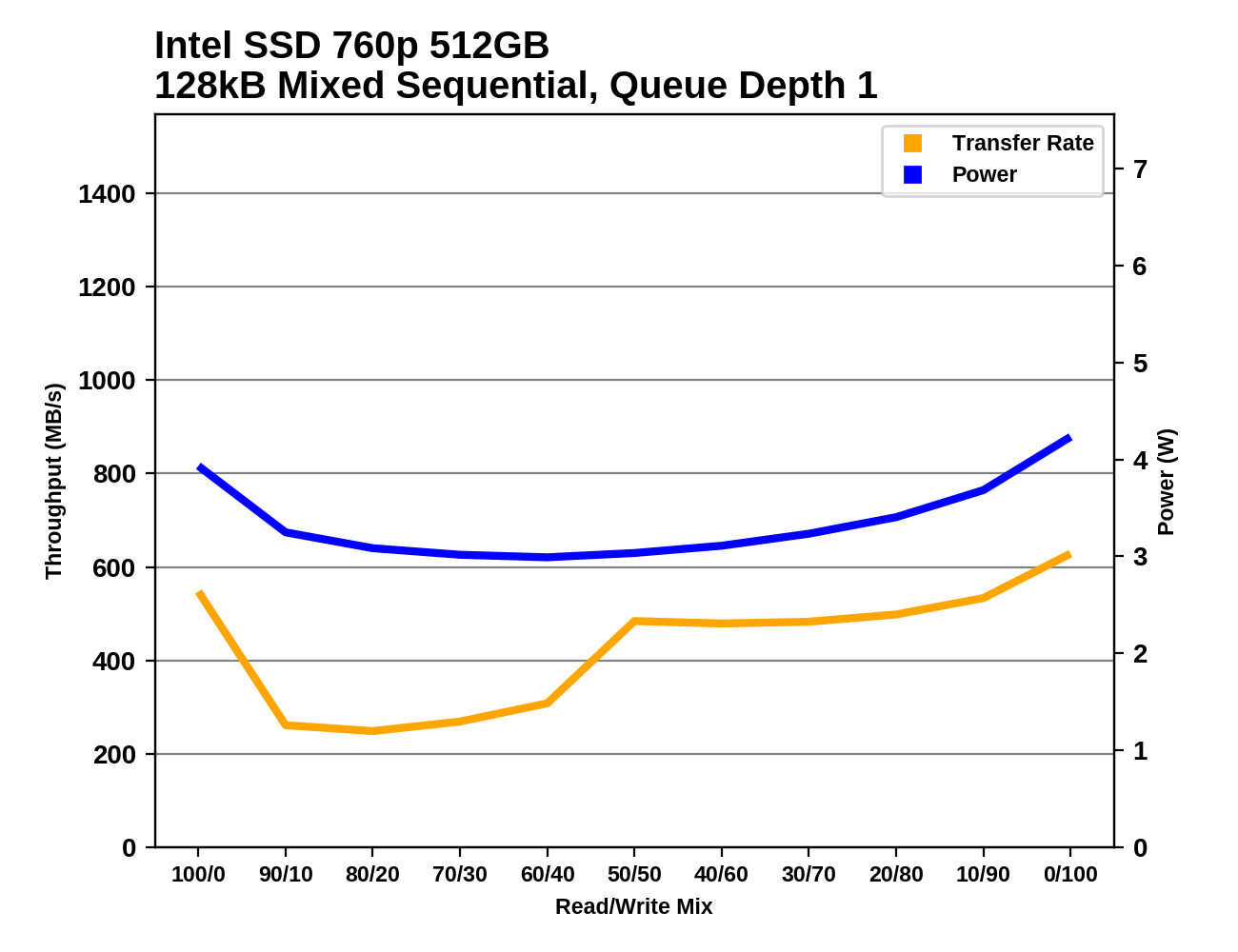 |
|||||||||
The Intel SSD 760p performs much worse during the first half of this test, when the workloads are more read-heavy. By contrast, Samsung's NVMe SSDs tend to be at their worst during the second half of the test. The Samsung drives are much faster at either end of the test when the workload is either pure reads or pure writes, and this helps the Samsung drives secure a clear lead in performance.
Power Management
Real-world client storage workloads leave SSDs idle most of the time, so the active power measurements presented earlier in this review only account for a small part of what determines a drive's suitability for battery-powered use. Especially under light use, the power efficiency of a SSD is determined mostly be how well it can save power when idle.
SATA SSDs are tested with SATA link power management disabled to measure their active idle power draw, and with it enabled for the deeper idle power consumption score and the idle wake-up latency test. Our testbed, like any ordinary desktop system, cannot trigger the deepest DevSleep idle state.
Idle power management for NVMe SSDs is far more complicated than for SATA SSDs. NVMe SSDs can support several different idle power states, and through the Autonomous Power State Transition (APST) feature the operating system can set a drive's policy for when to drop down to a lower power state. There is typically a tradeoff in that lower-power states take longer to enter and wake up from, so the choice about what power states to use may differ for desktop and notebooks.
We report two idle power measurements. Active idle is representative of a typical desktop, where none of the advanced PCIe link or NVMe power saving features are enabled and the drive is immediately ready to process new commands. The idle power consumption metric is measured with PCIe Active State Power Management L1.2 state enabled and NVMe APST enabled.
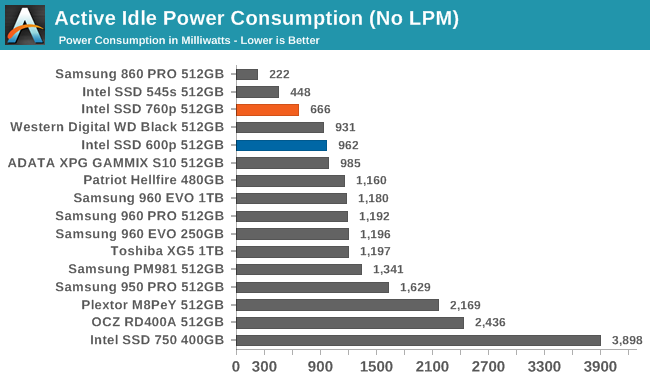
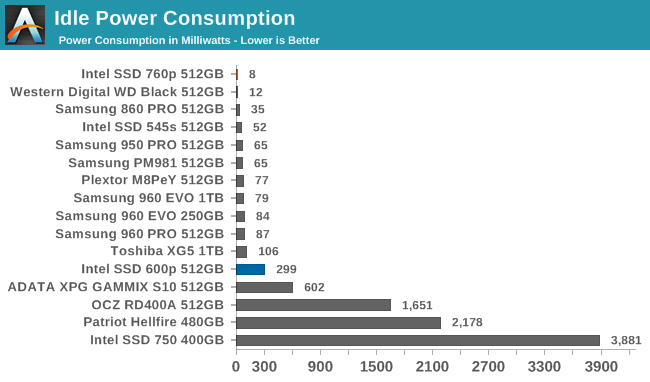
Updated February 1, 2018: The first time we ran the Intel SSD 760p through our idle power tests, it didn't go so well. The active idle power improvement brought by the SM2262 controller was clear, but when all the deeper idle power states were re-enabled the 760p actually started using more power. We haven't been able to fully determine what went wrong with that test run, but further investigation has revealed at least one apparent but minor bug in how the 760p handles the NVMe APST feature.
After turning off APST (and PCIe ASPM) to get the active idle power reading and a baseline for the idle wake-up latency, our test script re-enables APST and ASPM then give the drive a few minutes to settle down into its deepest sleep state before recording the idle power measurement. From what we have observed, this is not sufficient to actually get the 760p to its lowest power level. Enabling PCIe ASPM saves significant power, but the drive remains in power state 0 (active) even after APST is turned back on. The drive doesn't drop down to power states 3 or 4 (idle) until it receives at least one more command, after which it will start using the lower power states.
During ordinary real-world usage, APST will either be off (many desktops) or on (most laptops) full-time, and this particular bug would never be triggered even momentarily. To work around this bug, we've adjusted the idle power test scripts to poke the drive with one extra command after re-enabling APST, and that has resulted in the 760p setting a new record for PCIe SSD power savings. Since we haven't re-tested all of our M.2 PCIe SSDs with our new Quarch programmable power module yet, we aren't 100% certain that the 760p is the lowest-power NVMe drive out there, but it looks likely. The deepest idle state of the 760p also compares favorably against 2.5" SATA SSD in slumber state, the deepest achievable on desktop systems. SATA SSDs in laptops that can make use of the DEVSLEEP state may beat the 760p's deepest idle state, but we aren't set up to measure that.
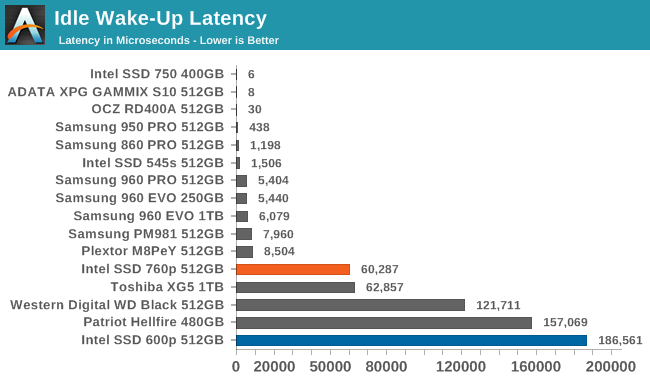
The excellent power savings in the deepest idle state provided by the Intel SSD 760p comes at the cost of a relatively sluggish 60ms wake-up latency. The 760p is still much quicker to wake up than the 600p was, and it is worth keeping in mind that not every transition out of idle will be this slow—the 760p has an intermediate idle state where it draws about 31mW and wakes up 1.8ms. During shorter idle periods, the 760p will be in this intermediate state that still offers an excellent balance of power and performance.
Conclusion
The Intel SSD 760p is intended to be a mainstream product for a retail SSD market that is increasingly migrating away from SATA SSDs. Critical to that goal, the Intel SSD 760p is almost always faster than any SATA SSD, and it is one of the first NVMe SSDs to offer idle power levels that are competitive with the best SATA SSDs. Those are important thresholds for budget NVMe SSDs, and the Intel 600p frequently fell short of that standard. And on the few synthetic tests where the 760p is slower than Samsung's new SATA king (the 860 PRO), it isn't far behind.
It was difficult to justify paying for the Intel 600p over a good SATA drive, because the workloads where the 600p was sure to outperform the SATA drive were the lighter tasks where either drive would be plenty fast. The Intel SSD 760p does not suffer from this problem. It handles light or heavy workloads well, and it doesn't lose much performance as it fills up. In any use case, the performance is a step up from SATA SSDs.
Compared to other NVMe SSDs, the 760p is clearly not a high-end drive. It beats the once-premium but now outdated 400GB Intel SSD 750 in most performance tests, but Samsung's recent NVMe SSDs are often far faster than the 760p. The Samsung 960 PRO is clearly in a different league from the 760p, but the TLC-based PM981 also outperforms the 760p and its eventual retail version may not carry much of a price premium over the 760p. The Samsung 960 EVO is currently a bit more expensive than the 760p but largely justifies that price.
Historically, TLC-based SSDs tend to be slower than MLC-based SSDs. That trend doesn't hold true at the moment: the combination of 64L 3D TLC and Silicon Motion's second-generation NVMe controller is competitive with the NVMe SSDs that paired Toshiba's 15nm planar MLC NAND with controllers from Phison and Marvell. Almost all SSD manufacturers are eliminating MLC NAND from their consumer product lines. The Intel SSD 760p, in turn, is one of several drives that show this can be a reasonable strategy. It works especially well for Intel since they have Optane SSDs to overshadow Samsung's MLC-based 960 PRO.
We expect the remaining NVMe products based on planar MLC NAND to quickly disappear from the market now that Toshiba and Micron are shipping 64L 3D TLC that works well with SSD controller solutions from Silicon Motion and Phison. Unlike when the mainstream SATA market first switched over to TLC, this transition shouldn't be a big step backwards for performance and endurance.
Even though the 760p represents a big step forward for Intel's consumer SSDs, it feels like Intel is still playing catch-up. Samsung's current 960 EVO has been offering somewhat better performance than the 760p for over a year, and the next generation based on the OEM PM981 should be announced soon. We are also looking forward to testing how well other new entry-level NVMe SSDs perform. Our samples of the MyDigitalSSD SBX based on the Phison E8 controller arrived yesterday. These drives are even cheaper than the Intel 760p, and DRAMless NVMe SSDs should be cheaper still.
Intel has been shipping their 64L 3D TLC to consumers since the June 2017 launch of the Intel 545s. They clearly needed to wait for a suitable controller and sufficient supplies of NAND before launching the 760p. Fortunately for them, most of their competition has also been unable to jump ahead. Compared to Samsung, Intel's consumer SSDs are lagging, but against the rest of the market, Intel is doing alright.
| NVMe SSD Price Comparison | ||||
| 120-128GB | 240-256GB | 400-512GB | 960-1200GB | |
| Intel SSD 760p | $72.99 (57¢/GB) | $108.99 (43¢/GB) | $198.99 (39¢/GB) | TBA |
| Intel SSD 600p | $79.52 (62¢/GB) | $139.06 (54¢/GB) | $203.55 (40¢/GB) | $399.00 (39¢/GB) |
| Intel SSD 750 | $482.00 (121¢/GB) | $749.99 (62¢/GB) | ||
| Samsung 960 PRO | $299.99 (59¢/GB) | $627.93 (61¢/GB) | ||
| Samsung 960 EVO | $119.99 (48¢/GB) | $229.99 (46¢/GB) | $495.90 (50¢/GB) | |
| Western Digital WD Black | $107.99 (42¢/GB) | $197.99 (39¢/GB) | ||
| Plextor M8Pe | $130.48 (102¢/GB) | $126.42 (49¢/GB) | $248.43 (49¢/GB) | $449.00 (44¢/GB) |
| MyDigitalSSD BPX | $79.99 (67¢/GB) | $129.99 (54¢/GB) | $219.99 (46¢/GB) | |
| MyDigitalSSD SBX | $62.99 (49¢/GB) | $99.99 (39¢/GB) | $184.99 (36¢/GB) | |
| Toshiba OCZ RD400 | $110.54 (86¢/GB) | $134.99 (53¢/GB) | $262.50 (51¢/GB) | $507.29 (50¢/GB) |
Meanwhile the pricing of the Intel SSD 600p doesn't stand out as clearly as it once did, but it is still nice to see the 760p debut below that level. The Western Digital WD Black matches the pricing on the 760p, and the 760p is a very clear winner in that match-up. With the 760p now on the market, Western Digital needs to start taking the NVMe market more seriously and update the WD Black as soon as possible.
Likewise, the drives still using planar MLC NAND are ready for retirement. They trade blows with the 760p on performance but they cost too much. Some—like the Intel SSD 750 and some Phison E7 drives—are clearly out of production and getting harder to find, but the Toshiba OCZ RD400 is still out there with an unjustifiable price and no publicly announced successor. The Plextor M8Pe is still on the market, but at least its successor M9Pe with 3D TLC has been announced and sampled for review and should hit the shelves soon.
In today's market, the Intel SSD 760p looks like a reasonable choice for an entry-level NVMe drive. But with so many big changes arriving this quarter and the next, it is hard to make predictions about where the 760p will stand in a few months. The entry-level NVMe market is starting to really take off, and we don't know who will be most aggressive with their pricing.

